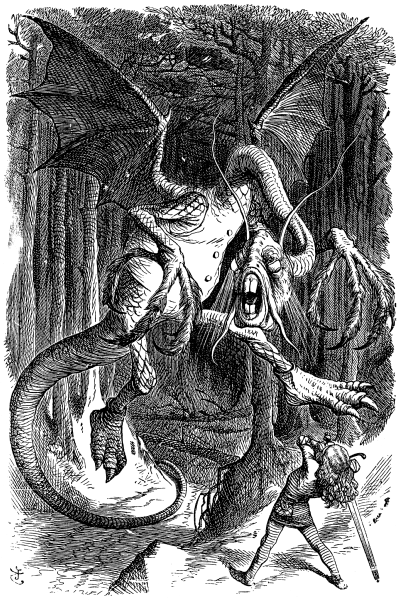’Twas brillig, and the slithy toves
Did gyre and gimble in the wabe:
All mimsy were the borogoves,
And the mome raths outgrabe.
“Beware the Jabberwock, my son!
The jaws that bite, the claws that catch!
Beware the Jubjub bird, and shun
The frumious Bandersnatch!”
He took his vorpal sword in hand;
Long time the manxome foe he sought—
So rested he by the Tumtum tree
And stood awhile in thought.
And, as in uffish thought he stood,
The Jabberwock, with eyes of flame,
Came whiffling through the tulgey wood,
And burbled as it came!
One, two! One, two! And through and through
The vorpal blade went snicker-snack!
He left it dead, and with its head
He went galumphing back.
“And hast thou slain the Jabberwock?
Come to my arms, my beamish boy!
O frabjous day! Callooh! Callay!”
He chortled in his joy.
’Twas brillig, and the slithy toves
Did gyre and gimble in the wabe:
All mimsy were the borogoves,
And the mome raths outgrabe.
Commentary
The Jabberwocky, as a nonsense poem, is an extreme form of literature that inherently demands decipherment, reminiscent of a puzzle or brain teaser. Here, ambiguity is used as a technique rather than a theme, so whilst the rhyme scheme and portrayal of a terrifying beast is regular and straightforward, the coinages Carroll uses, infused with experimental onomatopoeia, makes for a complex read. With words such as “snicker-snack” (l.18), the authorial intention seems to be simply to provide a narrative for the reader to embellish with their own thoughts and ideas. Given the multiplicity of the words’ meaning deep-rooted in the poem, any deciphered interpretation is negotiable.

Comments are closed.